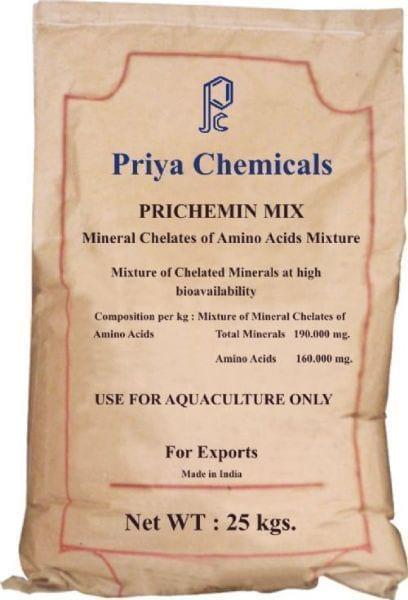Explore all the information on
Fish feed and nutrition
Welcome to the page about Fish feed and nutrition of Engormix; a source of knowledge on Fish feed and nutrition.
The efficacy of a single cell protein (SCP) methanotroph (Methylococcus capsulatus, Bath) bacteria meal (FeedKind®, Calysta, Menlo Park, CA, United States), in Pacific white shrimp (Penaeus vannamei) diets was studied to determine growth performance, survival rate and disease resistance against Vibrio parahaemolyticus causing Acute Hepatopancreatic Necrosis Disease (AHPND). The growth trial was assigned in a completely randomized design (CRD) with four treatments and 5 replicates of...
Comments : 0
Recommendations: 1
1. Introduction In Nigeria today, despite the significant investment in commercial agriculture by the government, aid agencies, multilateral organizations and individuals, livestock production has not succeeded in meeting the protein demands in the country (Oluwatayo and Adedeji, 2019) [1]. The increasing human population in the country has indicated that the conventional forms of livestock production and artisanal fisheries which have been over-exploited will not be sufficient...
Comments : 5
Recommendations: 4


PRICHEMIN MIX
Priya's PRICHEMIN MIX is a mineral supplement for aquaculture. It consists of a mix of mineral chelats from aminoacids
Suggested link
INTRODUCTION The macroscopic algae has always been associated with human and animal life for their innumerable beneficial properties and has been used as a source of food, feed, fertilizer, medicine and the availability of economically cheap phytochemicals.[1,2] Seaweeds are also used as raw material for many industrial products like agar, alginates and carrageenan.[3,4,5] Fresh and dry seaweeds especially brown and red macroalgae are extensively consumed by people especially...
Comments : 0
Recommendations: 0
Gut health results from interactions of host-specific intrinsic characteristics with several factors such as environment microbiome, nutritional status, feed quality, biotic and abiotic stress. Disturbances can be hard to predict and are observed as...
Comments : 0
Recommendations: 1


PRICHEMIN MIX
Priya's PRICHEMIN MIX is a mineral supplement for aquaculture. It consists of a mix of mineral chelats from aminoacids
Suggested link
INTRODUCTION Among the essential amino acids (AA), L-arginine (ARG) is one of the functional amino acids in animals. ARG is a nutritionally very important and essential AA for fish, and is considered the fourth limiting AA in aquafeed. Most of fish species excretes ammonia predominantly through the gills, diffusing NH 3 or NH 4 (ammoniotelic animals). Therefore, unlike mammals, fish have a low hepatic activity of carbamoyl phosphate synthase III or ornithine carbamoyl...
Comments : 0
Recommendations: 1
The white shrimp Litopenaeus vannamei has widely replaced Penaeus monodon as the cultured species. One of the reasons for this change is the fact that L. vannamei can be cultured in higher densities and with a lower exchange of water, which increases the bio-security. ...
Comments : 15
Recommendations: 0


PRICHEMIN MIX
Priya's PRICHEMIN MIX is a mineral supplement for aquaculture. It consists of a mix of mineral chelats from aminoacids
Suggested link
Introduction Fish plays a very important role in nutrition supply for people. Scientists believe that better health of the people can be ensured quickly and economically through greater production of fish (Bargstram, 1961). Nutritional studies have proved that fish protein rank in the same class as chicken protein and are superior to beef protein, milk and egg albumin (Srivastava, 1959)...
Comments : 1
Recommendations: 0
1. INTRODUCTION Histidine (Hist) is one of the 10 essential amino acids for fish, and its importance in nutrition expanding the role of this amino acid beyond its function in protein synthesis. It is well recognized that histidine deficiency can impair growth as well as feed conversion in fish (1, 2). Its metabolites, such as carnosine, anserine and NAH (N-acetyl histidine) play an important role in antioxidant capacity, recovery from fatigue and regulation of osmotic pressure...
Comments : 0
Recommendations: 0


PRICHEMIN MIX
Priya's PRICHEMIN MIX is a mineral supplement for aquaculture. It consists of a mix of mineral chelats from aminoacids
Suggested link
I. INTRODUCTION Nile Tilapia (Oreochromis niloticus) is one of the most commonly cultured freshwater fish species in Nigeria. It is a prolific breeder, widely farmed across the nations of the earth and the third largest cultured finfish [1]. Oreochromis niloticus is a native of Africa [2], considered as a standout farmed fish because of its high nutritional qualities, fast growth rate, resistance to diseases and its ability to withstand sudden environmental changes [3]. In spite...
Comments : 0
Recommendations: 1
In a farming environment, the homeostasis of aquatic animals can be disrupted by several factors, such as water quality, stocking density, diet, sanitary status, pollution, and contaminants, etc. Sub-optimal conditions, depending on their intensity and duration, can result in acute or...
Comments : 0
Recommendations: 2


PRICHEMIN MIX
Priya's PRICHEMIN MIX is a mineral supplement for aquaculture. It consists of a mix of mineral chelats from aminoacids
Suggested link
Olivier Decamp (INVE Aquaculture) gave a presentation about the industry challenges and the contribution of probiotics in the increased production of shrimp, during the CIAC Trade-show....
Comments : 4
Recommendations: 3
World food supplies must not only meet the needs of an expanding population but it must also provide for increased consumption as the standard of living of the existing population improves. This means the demand for resources is rising exponentially and is one of the biggest challenges facing agriculture since the "green revolution". Projections from the Food and Agriculture Organization (FAO) of the United Nations, estimate the animal protein requirement of 2050 to be about...
Comments : 5
Recommendations: 0


PRICHEMIN MIX
Priya's PRICHEMIN MIX is a mineral supplement for aquaculture. It consists of a mix of mineral chelats from aminoacids
Suggested link
Introduction Hematological parameters of fish blood are useful tools that aid in the study immuno-potentiators. Such tests are general but not conclusive and must be correlated with biochemical tests of the subject. The classification of leucocytes as in the vertebrates has been done following morphological criteria where by various groups can be distinguished such as lymphocytes, granulocytes and macrophages (Ellis, 1981). Dominguez et al. (2004) confirmed that elevating...
Comments : 0
Recommendations: 1
Functional yeast proteins supplementation in reduced fishmeal diets for orange-spotted grouper ( Epinephelus coioides ) reduces gut inflammation, improves villi structure and increase survival after Vibrio harveyi disease...
Comments : 5
Recommendations: 1


PRICHEMIN MIX
Priya's PRICHEMIN MIX is a mineral supplement for aquaculture. It consists of a mix of mineral chelats from aminoacids
Suggested link
Study shows improved productivity and profitability in cage-farmed tilapia in Brazil. View of the tilapia cages used in the study. In Nile tilapia...
Comments : 1
Recommendations: 1
SUMMARY
The protein requirements of fingerlings grey mullet, Mugil cephalus with an initial body weight of 5.5 g on the average, were studied by using four diets containing 32, 36, 40 and 44% crude protein, and fed for 90 days. The best growth performance was obtained with 36% crude protein and carbohydrate 35%, followed by the diets containing 40, 44 and 32% crude protein respectively. Protein efficiency ratio was decreased with increasing dietary protein...
Comments : 2
Recommendations: 0


PRICHEMIN MIX
Priya's PRICHEMIN MIX is a mineral supplement for aquaculture. It consists of a mix of mineral chelats from aminoacids
Suggested link
Application of feeds in aquaculture can increase both production and profits considerable. Nutrition encompasses the chemical and physiological process which provides nutrients to an animal for normal function, increase in immunity, disease resistance, maintenance and growth. It involves ingestion, digestion, absorption and transport of nutrients and removal of waste. There are 20 recognized inorganic elements which perform essential functions in body. Some...
Comments : 3
Recommendations: 2
Pathogenic agents that cause economic impacts in aquaculture are from bacterial, viral, fungal and/or parasitic origin. In fact, the combination of one or more of these pathogens is the most common cause of disease outbreak and can increase disease...
Comments : 2
Recommendations: 4


PRICHEMIN MIX
Priya's PRICHEMIN MIX is a mineral supplement for aquaculture. It consists of a mix of mineral chelats from aminoacids
Suggested link
Introduction Much information is given ( Willem Van Cotthem, 2012 ) about Opuntia ficus-indica as an aloes. Therefore, the aim of the present study was evaluating the possibility of using powders of either fruits' skins or leaves of the Egyptian Teen Shoky as replacers for dietary corn in all-males mono-sex Nile tilapia, Oreochromis niloticus diets and their effects on fish performance for 75 days. This is an attempt to ameliorate feed costs by...
Comments : 1
Recommendations: 0
INTRODUCTION The increasing global population and the limiting global capture fisheries undeniably increase the demand of aquaculture. On the other hand, those will also bring about limitation to aquaculture expansion in particular of land and water utilization. Therefore, productivity enhancement in term of total production per input used becomes one of the major priority in the development of aquaculture (Avnimelech et al., 2008) . Aquaculture is the culture of...
Comments : 0
Recommendations: 0












